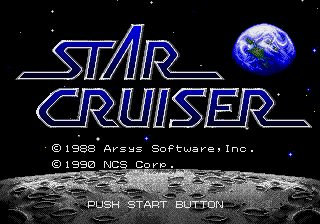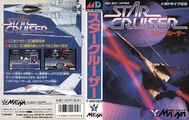Star Cruiser
From Sega Retro
This teeny-tiny article needs some work. You can help us by expanding it.
| Star Cruiser | |||||
|---|---|---|---|---|---|
| System(s): Sega Mega Drive | |||||
| Publisher: Masaya | |||||
| Developer: Arsys Software | |||||
| Genre: Adventure / FPS / RPG | |||||
|
Star Cruiser (スタークルーザー) is a 1990 FPS/RPG/adventure game for the Sega Mega Drive by Arsys Software, published by NCS. It is a port of Star Cruiser, which was previously released on various Japanese home computers, including NEC's PC-88 and PC-98 in 1988 and the Sharp X68000 in 1989.
No version has been released outside Japan. An English version, Star Quest, was planned for North American release in 1994, but was cancelled. A sequel, Star Cruiser II, was released for Japanese home computers in 1992.
Overview
Ahead of its time, it featured fully 3D polygonal graphics, true FPS gameplay (including strafing), open-ended space exploration, and an epic sci-fi space opera plot.
The game's innovations included fully polygonal 3D graphics (including nearly all objects, enemies, and backgrounds, with the exception of distant horizons that were pre-rendered), true first-person shooter gameplay (anticipating Wolfenstein 3D and Doom), gameplay mechanics such as strafing, fusion of first-person shooter and RPG mechanics (anticipating System Shock and Deus Ex), 3D open-ended sandbox exploration across a large game universe (spanning several star systems) with six degrees of freedom, 3D space flight simulator gameplay for exploring (and fighting enemy spacecraft in) outer space, a crosshair to target enemies (both on ground and in space), and a portable computer built into the player character's power suit that has various uses (such as displaying an automap and radar). The game had a large open-ended game universe, allowing the player to explore over 30 planets across four star systems.
The game also emphasized storytelling, with an epic sci-fi space opera storyline set in the 27th century, various plot twists, extensive character dialogues with NPCs (who have their own background stories), anime-style dialogue portraits for characters, visual novel style POV cutscenes, and animated cutscenes rendered using the game's 3D engine. It also had a chiptune FM synthesis soundtrack composed by Toshiya Yamanaka (later released as a seperate original soundtrack CD).
Reception
- See Physical Scans for review scores
The original home computer releases were critically acclaimed, particularly the Sharp X68000 version, winning a number of awards from Japanese publications. However, the Mega Drive port had a mixed reception, with Japanese reviewers not considering it to be as good as the original computer versions. European import reviews were more critical, considering the heavy Japanese text to be a major obstacle to enjoying the game. However, Electronic Gaming Monthly's preview of the unreleased English version, Star Quest, was generally positive.[1][2]
Physical Scans
| Sega Retro Average | ||||||||||||||||||||||||||||||||||
|---|---|---|---|---|---|---|---|---|---|---|---|---|---|---|---|---|---|---|---|---|---|---|---|---|---|---|---|---|---|---|---|---|---|---|
|
| 53 | |
|---|---|
| Based on 6 reviews | |
- ↑ http://static.giantbomb.com/uploads/original/13/139866/2720737-electronic_gaming_monthly_051_-_1993_oct_108.jpg
- ↑ http://static.giantbomb.com/uploads/original/13/139866/2428447-electronic_gaming_monthly_59_190.jpg
- ↑ Beep! MegaDrive, "January 1991" (JP; 1990-12-08), page 35
- ↑ Famitsu, "" (JP; 199x-xx-xx), page 1
- ↑ Hippon Super, "January 1991" (JP; 1990-12-04), page 40
- ↑ Joystick, "Mars 1991" (FR; 1991-0x-xx), page 134
- ↑ Mega Drive Fan, "March 1991" (JP; 1991-02-08), page 99
- ↑ Sega Power, "October 1991" (UK; 1991-09-05), page 54
- Sub-stubs
- No players field
- Use romtable template
- All games
- External JPEG reference
- Old-style rating (famitsu)
- Rating without source
- Old-style rating (famitsucom)
- External rating reference
- Old-style rating (joystick)
- Rating without PDF source
- Old-style rating (mdag)
- Old-style rating (segapower)
- Old-style rating (segapro)
- Update ratings template
- 6 old ratings

